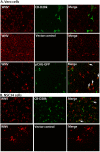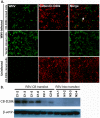Inhibition of West Nile virus by calbindin-D28k
- PMID: 25180779
- PMCID: PMC4152291
- DOI: 10.1371/journal.pone.0106535
Inhibition of West Nile virus by calbindin-D28k
Abstract
Evidence indicates that West Nile virus (WNV) employs Ca(2+) influx for its replication. Moreover, calcium buffer proteins, such as calbindin D28k (CB-D28k), may play an important role mitigating cellular destruction due to disease processes, and more specifically, in some neurological diseases. We addressed the hypothesis that CB-D28k inhibits WNV replication in cell culture and infected rodents. WNV envelope immunoreactivity (ir) was not readily co-localized with CB-D28k ir in WNV-infected Vero 76 or motor neuron-like NSC34 cells that were either stably or transiently transfected with plasmids coding for CB-D28k gene. This was confirmed in cultured cells fixed on glass coverslips and by flow cytometry. Moreover, WNV infectious titers were reduced in CB-D28k-transfected cells. As in cell culture studies, WNV env ir was not co-localized with CB-D28k ir in the cortex of an infected WNV hamster, or in the hippocampus of an infected mouse. Motor neurons in the spinal cord typically do not express CB-D28k and are susceptible to WNV infection. Yet, CB-D28k was detected in the surviving motor neurons after the initial phase of WNV infection in hamsters. These data suggested that induction of CB-D28k elicit a neuroprotective response to WNV infection.
Conflict of interest statement
Figures







References
-
- Christakos S, Barletta F, Huening M, Dhawan P, Liu Y, et al. (2003) Vitamin D target proteins: function and regulation. Journal of cellular biochemistry 88: 238–244. - PubMed
-
- Mattson MP, Rychlik B, Chu C, Christakos S (1991) Evidence for calcium-reducing and excito-protective roles for the calcium-binding protein calbindin-D28k in cultured hippocampal neurons. Neuron 6: 41–51. - PubMed
Publication types
MeSH terms
Substances
Grants and funding
LinkOut - more resources
Full Text Sources
Other Literature Sources
Research Materials
Miscellaneous

